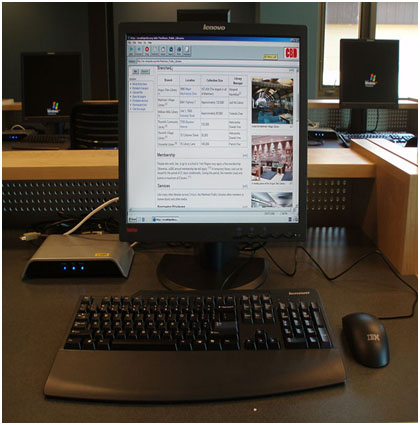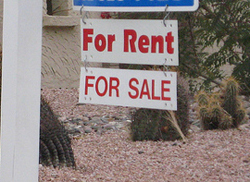
One character stands for danger; the other for opportunity.
In a crisis, be aware of the danger-but recognize the opportunity.
Never has that been more accurate than now, for with the green approach business can not only help the planet to forestall long term danger (for which they themselves will have to pay in increased costs as resources become scarce and as business becomes impacted by inclement weather), but they also reduce their bottom line while improving morale and productivity of their workforce.
How is this done?
The first place the office can look is to technology that uses or relies upon electricity. This can range from the simple coffeemaker left on all night to the replacement of servers to a thin client (pictured below) resulting, in some cases, in a significant reduction of a company’s annual expense.

But other efforts can pay dividends, as well, in ways that are not quantifiable, such as organizing the workforce to come together as a green team to unplug adaptors when not in use or to compete with one another for prizes or dividends by recycling ink cartridges and other expensive items.
These efforts can become rallying points for the office or cooperation which then leads to increased productivity.
Another area is with computers and monitors that use less energy and that will, eventually (hopefully) be made without the intense greenhouse gasses that are now part of the LCD and Plasma manufacture process. There are companies, such as VIZIO (see below; note: this is not an endorsement), that are introducing a line of energy efficient models likely to drop in price over time (some are low cost now).

These products are rated to pull less electricity to run. Put that together with any sized office and one can see significant savings on their bill over time.
The paperless office is another area that has been talked about but how realistic has it become? Most work situations do require the use of paper and that is another potential for savings.
I am reminded of a scene in Robert Graves’ I CLAUDIUS, where Antonia, the daughter of Marc Antony, complains that her family has thrown away perfectly good paper that had barely been written upon.

(There’s that other part of the story where she finds a plot against Tiberius Caesar on one of those discarded scraps… while intrigue and politics can be an inevitable part of the office, I doubt we have to worry about it to the extent of the trials and tribulations of Ancient Rome).
But Antonia had a good idea that still holds true. While many companies buy 95 brightness or above virgin paper and spend a great deal to see most of it discarded, recycled paper of a lesser or equal brightness can work perfectly well for the day to day activities in an office and, again, the effort to then recycle afterward can be an opportunity to build community within the office.
Then there is telecommuting as not every community needs to be in the same physical location and here’s where significant savings can be achieved. There’s been resistance to this option in offices as managers struggle to keep their workforce motivated and in communication with one another. However, the combination of technology and incentives can help to cut the wheat from the chaff and allow an office to then reduce its energy footprint and the need to buy equipment (as many home office workers provide their own).
How is this done? Start slowly and use incentives to allow workers to take one day or half day a week at home so that you can evaluate their performance. Use meeting software (such as virtual e-rooms) that allow real time interaction and set up video to video (most computers can provide this now) for meetings. This can then be part of a reward for the recycling efforts that help to reduce the bottom line (a new ink cartridge can cost many times more than a refilled version).
When a worker does not show the discipline to turn in their work effectively or requires more communication than had been indicated by their onsite performance, offsite work can also be a valuable tool for assessing strengths and weaknesses. Such a worker can then be mentored by another who does not have performance issues with offsite effort. If that does not work, you’ve identified who you can rely upon for offsite (and reduced cost work) and who will be the worker you will assign to the office to be the anchor you will need onsite.
As for the thin client concept, this requires onsite evaluation as it is one of the most significant financial commitments a company can make to their infrastructure. The advantages are that thin client server configurations can also reduce a company’s power consumption by such a significant percentage, while upgrading the company’s systems to a more modern technology, the company will see a direct return on investment within a very short period of time while enjoying – again – increased productivity by their workforce through better systems.
Thin client technology can also eliminate the need for controlled environments, such as specialized air conditioning; quite often a company’s most significant power outlay.
It is important, however, not to rush to the thin client model in isolation. It requires, in my opinion, an experienced consultant to perform a requirements and business reengineering analysis or it could cost a company more than it saves.
One of the most rewarding areas for greening your office has to do with green space and sustainability for those who have that control over their environment. Planting trees for shade on a building’s western exposure can cut significant consumption costs in a hot climate while reducing the need to water lawns – or better yet – the drought resistant plants (aka xeriscaping - symbol below) you’ve put in place instead of your lawn.

Finally, there are the easiest and most socially responsible options for greening your office. Using soy ink in your toners is an example. Furniture produced from sustainable forestry is another (this is a very important consideration as the EU has just reported that the cost of forest loss exceeds the current financial crisis). LED or compact florescent light bulbs, of course (I prefer LED; longer life, less consumption, easier on the eyes and not full of harmful chemicals). There are many cleansers and solvents that don’t pollute the earth and break room supplies that are recycled (or better yet, mugs for employees instead of paper cups!).
The list is endless as are the supplies that are now available. It only requires only the decision to order one thing over another by incentivizing your procurement personnel to choose the green option over the alternative. None of it has to cost more than you already spend and, in many cases, it will be less and that is opportunity in a recession to receive dividends for the earth.
The timing for the green office has never been better.
Bio:
Janet Ritz is the publisher and managing editor of THE ENVIRONMENTALIST, an environmental contributor to The Huffington Post and a green consultant that specializes in reducing costs and carbon footprint.
[ 3 comments ] ( 355 views ) | [ 0 trackbacks ] | permalink |




 ( 3 / 2587 )
( 3 / 2587 ) Normally we might not think of “port” and “green” in the same sentence. Ports, with all their ships and trucks and emissions, might not seem like the greenest of businesses. Not so with the Port of San Diego.
Port officials will be the first to admit ports historically haven’t been easy on the environment. Check out this 2007 article in The San Diego Union-Tribune on a port study revealing ships “accounted for most of the nitrogen oxides, sulfur dioxide and particle emissions” in 2006. Port activities coughed up 128,000 tons of greenhouse gases in 2006.
Nothing like some cold, hard numbers to give you a green kick in the pants.
So, in 2007, the Board of Port Commissioners approved an Environmental Sustainability Policy and the Port of San Diego is implementing green goals and striving to protect San Diego’s beautiful coastline.

(Image courtesy Port of San Diego)
The Green Port program covers six key areas:
1. Water – With a goal of improving water quality in San Diego Bay and reducing the port’s water usage, including decreasing water use at the port’s administration building by 10 percent.
2. Energy – The goal is to conserve energy and maximize energy efficiency, including alternative energy technology.
3. Air – The port plans to reduce greenhouse gas and other air emissions and determine its carbon footprint.
4. Waste management – The goal is to reduce waste through reuse, recycling and composting.
5. Sustainable development – The port plans to enhance the environmental performance of its buildings and incorporate green principles into new development.
6. Sustainable business practices – In making decisions, the port will consider environmental, economic and social concerns. Additional goals include educating port staff on the Green Port program and creating a Green Port Web presence.
The port approved 23 green projects it wanted to complete by the end of 2008. According to the checklist on its Web site, 15 have been checked off, six are in progress and two have been deferred.
The port has also created a Web site of green resources useful to the general public, including healthy garden/home brochures, lists of environmental tips and a page dedicated to Eastern Pacific green sea turtles that pass through the San Diego Bay.
A Green Thumbs Up to the port for its initiatives and for creating a Web site that not only outlines its green efforts, but also gives San Diego residents resources and information. All businesses could take a cue from the port and work toward going green.
Like the port, create a list of goals or objectives. Having your plan in writing makes it real and gives your employees a detailed outline of what is expected of them when it comes to making the office more environmentally friendly.
A key component of the port’s efforts is education – both the staff and the general public. Take the time to educate your staff on your green policies and on how they can implement green efforts in their home lives as well.
If your employees truly understand the benefits of going green, it will make them much more likely to buy into and participate in your initiatives. All the recycling bins in the world won’t help if your employees aren’t using them and don’t really understand why they should.
You can read all about the Green Port program online.
----
Look for a new feature in February highlighting green offices. If you have a green office, particularly if you are located in San Diego, and would like to share your tips for going green on the Green Office Blog, please send an e-mail to holly AT hollyannfisher.com. Go green!
[ add comment ] ( 238 views ) | [ 0 trackbacks ] | permalink |




 ( 3 / 2405 )
( 3 / 2405 ) The year 2009 is barely started and we’re seeing green everywhere! We give a hearty Green Thumbs Up to the following initiatives for promoting green business.
The California Association of Realtors has launched “ At home with green,” a new Web site dedicated to informing homeowners, real estate agents and the public about how to make their homes green.

(Photo by John Hall Associates)
About a year ago, the association created a Green Task Force to lead the organization in becoming greener and educating its members and the public about green real estate. The result is a pretty nifty Web site of resources and information.
And, in case you’re wondering why green is a real estate issue, the association says: “Did you know that in the United States, homes are responsible for 21 percent of the nation’s greenhouse gas emissions? That fact, plus rising energy costs and a decision by California’s Public Utilities Commission mandating that new housing developments are zero net energy by 2020, has caused consumers, homebuilders, homeowners, property managers, Realtors, local governments, schools and others to focus on the energy-efficiency of homes and buildings. That’s why real estate is a green issue.”
Go, California!
Proof is out this week that green efforts have a powerful economic impact. Research group Next 10 has published the 2009 California Green Innovation Index, revealing the economic shot in the arm green initiatives can give a state’s economy. A couple key findings include the fact green jobs have grown 10 times faster than total job growth since 2005 and green tech venture capital investments almost doubled in the span of a year, reaching a high of $3.3 billion last year (57 percent of the national total).
“As the country moves quickly to put an economic stimulus package in place, California’s experience with energy efficiency and clean technology is instructive,” said F. Noel Perry, venture capitalist and founder of the nonpartisan, nonprofit Next 10, in a news release announcing the findings. “If California had not moved as forcefully to decrease energy consumption over the last three decades, we would be in a much more precarious economic position right now. Imagine where the country could be if it were as efficient as California.”
Read the full report online.
Win your own green space
And, finally, a Green Thumbs Up to Green Spaces, a resource for green businesses in New York. The organization is sponsoring a competition for green startups in New York. The first-place winner gets $8,000 in investment capital, one rent-free year at a Green Spaces office valued at $6,000, and a package of marketing, legal and financial services valued at $11,000.
“Our mission is to make sure New York’s pool of promising new green businesses has a real shot at changing the marketplace for the good of the environment,” said Green Spaces CEO and founder Jennie Nevin.
Click here for full details on the competition.
[ 1 comment ] ( 149 views ) | [ 0 trackbacks ] | permalink |




 ( 3 / 2518 )
( 3 / 2518 ) By now, we all know to recycle office paper, ditch the plastic bottles and fill the break room with reusable coffee mugs. Got it. But did you realize there are a few items lurking in your office that take a little more energy to recycle, but definitely should not end up in your office trash can?
Batteries
Just about every cubicle or home office has a wireless keyboard and mouse. Some have charging stations, but many take batteries. Most of us are used to picking up a package of single-use batteries, using them until they die and tossing them in the trash. Not good.
According to Earth911.com, Americans throw out almost 180,000 tons of batteries each year. About 14,000 of those tons are rechargeable batteries; the rest are single-use. Eek. Batteries that end up in local landfills emit heavy metals and toxic substances into the air and water.
First, look for a keyboard/mouse that has a charging station, which eliminates the use of batteries altogether. If that’s not an option, purchase rechargeable batteries, which certainly have a longer life span than single-use batteries.
Eventually, though, the rechargeable batteries will need to be replaced. The good news is they can be recycled. The Rechargeable Battery Recycling Corp. is a great resource for figuring out how to recycle rechargeable batteries.
California is one state that requires retailers who sell small, rechargeable batteries to provide customers with a free system for returning those batteries for proper recycling or disposal. In California, the same goes for retailers who sell cell phones.
Compact fluorescent light bulbs
While natural light is always best, sometimes a window-less conference room needs a light bulb.
It’s great to put a CFL bulb in your desk lamp, but what happens when it burns out? It might be tempting to loss it in the garage can, but CFL bulbs do contain a small amount of mercury (about 4 milligrams, according to www.EnergyStar.gov) and should be recycled.
This EPA site contains information about CFL bulbs and how to recycle them. We give a Green Thumbs Up to Home Depot, which last year announced it would recycle CFL bulbs at all its store locations. The service is free. In April 2007, Home Depot announced a number of Eco Options, including recycling at its corporate headquarters and a store recycling program focused on recycling shrink wrap and other plastics. Read more about Home Depot’s efforts here.
Ink cartridges
Always stop and think about whether you really need to print a particular document. Scaling back on your overall printing saves money on ink, paper and printer wear and tear.
Of course in any office environment, some contract or schedule needs to live on paper. When it comes time to replace your ink cartridge, be sure to recycle the cartridge. If you have a super-duper deluxe printer, check with the manufacturer about how to recycle the cartridges.
If you’re using an ink-jet printer, most office supply stores will take your old cartridges. Some will give you credit toward future purchases or a free ream of paper. Some companies, like Ecco Recycles, will pay you for used ink cartridges or make a donation to a charity.
You can’t have a truly green office if you don’t recycle everything you possibly can. Even though it take a little extra effort on your part, recycling everything from batteries to keyboards is getting easier. Besides, you’ll feel better knowing yesterday’s batteries aren’t tomorrow’s pollution.
Check out this great resource: Plug your zip code and what you need to recycle into www.Earth911.com to find the recycling center closest to your office.
[ 3 comments ] ( 165 views ) | [ 0 trackbacks ] | permalink |




 ( 3 / 2398 )
( 3 / 2398 ) Photo by Refracted Moments
OK, pop quiz: What does every office have?
Answer: A coffee pot. Truly, have you ever been to a place of business that didn’t smell just a little like a cup of java. And those of you who work from home probably have a coffeemaker in the kitchen.
Even a small business most likely goes through three to five pots of coffee each day – that’s at least 15 pots of coffee each work week. And where do the coffee grounds probably end up: in the garbage can.
In an effort to make your office – whether it has 200 employees or 2 – a little greener, give those used coffee grounds a new mission. Coffee grounds are great plant food, can be used as mulch and are a perfect addition to your compost pile.
Here are some great tips on how to use coffee grounds.

By reusing coffee grounds, you’re cutting down on office waste and giving Mother Nature a helping hand.
The key to this idea is making it easy for your employees to get involved.
• Save the bags the coffee came in and dump the grounds (filters can be used in a compost pile too) back into those bags. Your employees can take them home and use them in their gardens or in their own compost piles.
• If you have a landscape crew, talk with it about how you can use the coffee grounds in the flowerbed or on the lawn.
• Contact your local horticulture group or garden club – they just might be willing to come by your office once a week and pick up your grounds.
Encourage your employees to compost at home. According to the EPA, yard trimmings and food waste together account for 24 percent of the U.S. municipal solid waste stream. That’s a lot of trash that could be put to a better use. Check out this EPA site on how to start composting.
So, fire up the coffee pot, but think twice before dumping the grounds.
[ 4 comments ] ( 92 views ) | [ 0 trackbacks ] | permalink |




 ( 3 / 2347 )
( 3 / 2347 ) 


 Looking for a Green Office Solution?
Looking for a Green Office Solution?